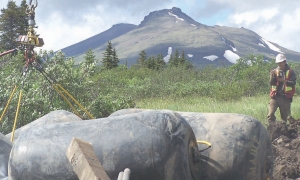VANCOUVER–The road has never been smooth for the Red Chris copper- gold project in northwest British Columbia. Now one more obstacle is out of the way.
The Federal Court of Appeal has overruled an earlier trial court decision that had rendered the federal environmental assessment of the project invalid. The assessment, which concluded Red Chris is unlikely to cause significant adverse environmental effects, is now reconfirmed and project owner Imperial Metals (III-T, IPMLF-O) is looking forward to moving the sizable deposit forward.
Imperial acquired bcMetals in early 2007 after a long battle with rival suitor Taseko Mines (TKO-T, TGB-X), eventually paying $74 million or $1.70 a share for the company. The prize in the battle was Red Chris, which hosts reserves of 276 million tonnes grading 0.249% copper and 0.266 gram gold per tonne according to a 2004 feasibility study. The study predicted a 25- year mine life at 30,000 tonnes processed a day.
Things seemed to be moving along nicely, propelled by an immense mineralized intercept in late 2007: 1,024 metres grading 1.01% copper, 1.26 grams gold per tonne and 3.92 grams silver.
As with all mining projects in B. C., Red Chris was subject to both provincial and federal environmental review. The federal authorities first scoped the project for comprehensive level review. After learning that the project was undergoing a full provincial environmental assessment, the federal authorities changed the scope of their study to a screening report, in keeping with efforts by provincial and federal environmental agencies to harmonize review processes.
In July 2005, the provincial environmental assessment concluded Red Chris was unlikely to cause significant adverse environmental effects. Ten months later, the federal authorities issued their screening report, which also concluded the project was environmentally sound.
But in late September, a federal court judge, spurred by a complaint by MiningWatch Canada, ruled that the Department of Fisheries and Oceans and Natural Resources Canada had no authority to change the scope of a federal environmental assessment.
That invalidated the screening-level federal environmental assessment and sent the federal environmental assessment back to the drawing board, a significant setback for the project.
Now, an appeals court judge has overruled that decision.
The Fisheries and Oceans, and Natural Resources ministers, the Attorney General of Canada, and Red Chris Development (a wholly owned subsidiary of Imperial) had all filed appeals. The issue was the discretion of the responsible federal authorities to determine the scope of a project assessment under the Canadian Environmental Assessment Act (CEAA).
The decision leaves Imperial clear of environmental assessment hurdles but other obstacles remain in the way. First, Imperial says the development of Red Chris into a mine depends on the construction of a power line to service the northwest portion of B. C. To that end, Imperial is actively involved in a coalition that is petitioning the provincial government to proceed with the Northwest power line project that it announced in late 2007 then cancelled a few months later, when NovaGold Resources (NG-T, NG-X) and Teck Cominco’s (TCK. B-T, TCK-N) Galore Creek copper-gold project was put on hold.
In addition, another court decision may cost the company some cash. The company Imperial took over to acquire Red Chris, bcMetals, lost a court challenge of validity of the bankruptcy petition of American Bullion. The bankruptcy of American Bullion allowed bcMetals to acquire the 24% of Red Chris that it did not already hold, without compensating American Bullion shareholders. A judge ruled that, in petitioning American Bullion into bankruptcy, bcMetals withheld key information about the value of the company’s assets and the legitimacy of its debts. The outcome is a victory for American Bullion shareholders but the outcome for Imperial — the sentence–has not been set.
Red Chris is by no means Imperial’s only project. The company owns the Mount Polley open-pit copper-gold mine in central B. C. and holds 50% of the Huckleberry open-pit copper-molybdenum mine in northern B. C. And while working towards development at Red Chris, Imperial is exploring the Sterling gold property in southwest Nevada.
At Mount Polley, a new estimate pegged reserves at 55.6 million tonnes grading 0.36% copper, 0.3 gram gold and 0.66 gram silver per tonne. During 2007, 6.4 million tonnes were mined; exploration efforts restocked 2.2 million tonnes. The current mine life for Mount Polley extends to late 2015 but drilling continues to expand the resources on site, with 104 million tonnes of mineral resources defined in addition to reserves. In 2007, the mill processed 6.4 million tonnes to produce 51.5 million lbs. copper, 34,164 oz. gold and 370,731 oz. silver.
Huckleberry still hosts reserves of 16.6 million tonnes grading 0.352% copper and 0.005% molybdenum. The mine milled 6.5 million tonnes in 2007 to produce 55.1 million lbs. copper, 5,847 oz. gold, 212,735 oz. silver and 304,224 lbs. molybdenum.
Imperial earned $22.7 million in 2007 from Mount Polley and Huckleberry.
Down at Sterling, an underground drilling program recently expanded the 144 zone to the east: hole 17 intersected 14 metres grading 5.08 grams gold and hole 27 cut 9 metres of 3.68 grams gold. In the high-grade core of the 144 zone, hole 22 returned 11.05 grams gold over 34 metres. And indicating that the zone remains open to the west, hole 24 returned 2.65 grams gold over 30 metres from beyond the zone’s western boundary.
A latite dyke divides the two halves of the mineralized system at Sterling and recent drilling has shown that mineralization continues across the dyke, opening it up as a target of future exploration.
In the two days following the Red Chris decision, Imperial gained $1.86 to close at $9.74. The company has a 52-week trading range of $7.82-19.37 and has 32.7 million shares issued.


Be the first to comment on "Red Chris back on track for Imperial Metals (June 30, 2008)"